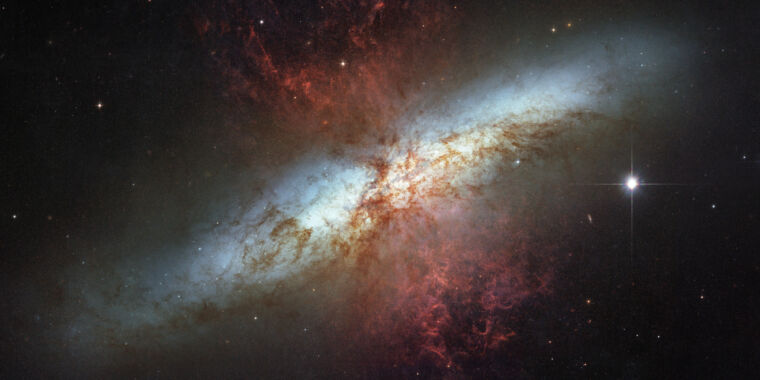We may have spotted the first magnetar flare outside our galaxy


NASA, ESA and the Hubble Heritage Team
Gamma rays are a broad category of high-energy photons, including everything with more energy than an X-ray. While they are often created by processes like radioactive decay, few astronomical events produce them in sufficient quantities that they can be detected when the radiation originates in another galaxy.
That said, the list is larger than one, which means detecting gamma rays doesn’t mean we know what event produced them. At lower energies, they can be produced in the areas around black holes and by neutron stars. Supernovae can also produce a sudden burst of gamma rays, as can the merger of compact objects like neutron stars.
And then there are magnetars. These are neutron stars that, at least temporarily, have extreme magnetic fields—over 1012 times stronger than the Sun’s magnetic field. Magnetars can experience flares and even giant flares where they send out copious amounts of energy, including gamma rays. These can be difficult to distinguish from gamma-ray bursts generated by the merger of compact objects, so the only confirmed magnetar giant bursts have happened in our own galaxy or its satellites. Until now, apparently.
What was that?
The burst in question was spotted by the ESA’s Integral gamma-ray observatory, among others, in November 2023. GRB 231115A was short, lasting only about 50 milliseconds at some wavelengths. While longer gamma-ray bursts can be produced by the formation of black holes during supernovae, this short burst is similar to those expected to be seen when neutron stars merge.
The directional data from Integral placed GRB 231115A right on top of a nearby galaxy, M82, which is also known as the Cigar Galaxy. M82 is what is called a starburst galaxy, which means that it’s forming stars at a rapid clip, with the burst likely to have been triggered by interactions with its neighbors. Overall, the galaxy is forming stars at a rate more than 10 times that of the Milky Way. That means lots of supernovae, but it also means a large population of young neutron stars, some of which will form magnetars.
That doesn’t rule out the possibility that M82 happened to be sitting in front of a gamma-ray burst from a distant event. However, the researchers use two different methods to show that this is pretty improbable, which leaves something happening inside the galaxy as being the most likely source of the gamma rays.
It could still be a gamma-ray burst happening within M82, except the estimated total energy of the burst is much lower than we’d expect from those events. A supernova should also be detected at other wavelengths, but there was no sign of one (and they typically produce longer bursts anyway). An alternative source, the fusion of two compact objects such as neutron stars, would have been detectable using our gravitational wave observatories, but no signal was apparent at this time. These events also frequently leave behind X-ray sources, but no new sources are visible in M82.
So, it looks like a magnetar giant flare, and the potential explanations for a brief burst of gamma radiation don’t really work for GRB 231115A.
Looking for more
The exact mechanism by which magnetars produce gamma rays isn’t entirely worked out. It is thought to involve the rearrangement of the crust of the neutron star, forced by the intense forces generated by the staggeringly intense magnetic field. Giant flares are thought to require magnetic field strengths of at least 1015 gauss; Earth’s magnetic field is less than one gauss.
Assuming that the event sent radiation off in all directions rather than directing it toward Earth, the researchers estimate that the total energy released was 1045 ergs, which translates to roughly 1022 megatons of TNT. So, while it’s less energetic than neutron star mergers, it’s still an impressively energetic event.
To understand them better, however, we probably need more than the three instances in our immediate neighborhood that are obviously associated with magnetars. So, being able to consistently identify when these events happen in more distant galaxies would be a big win for astronomers. The results could help us develop a template for distinguishing when we’re looking at a giant flare instead of alternative sources of gamma rays.
The researchers also note that this is the second candidate giant flare associated with M82 and, as mentioned above, starburst galaxies would be expected to be relatively rich in magnetars. Focusing searches on it and similar galaxies might be what we need to boost the frequency of our observations.
Nature, 2024. DOI: 10.1038/s41586-024-07285-4 (About DOIs).
Source link




